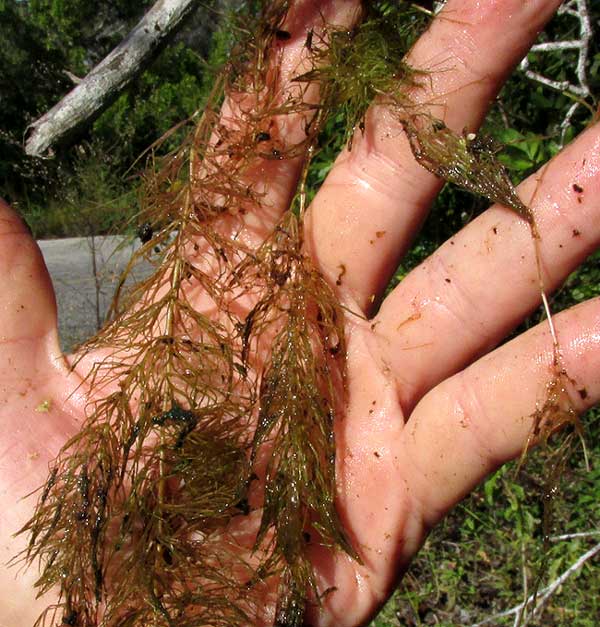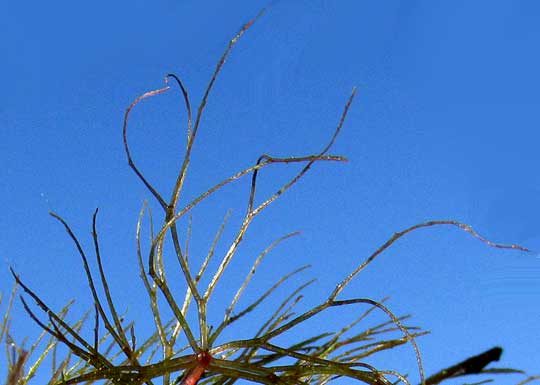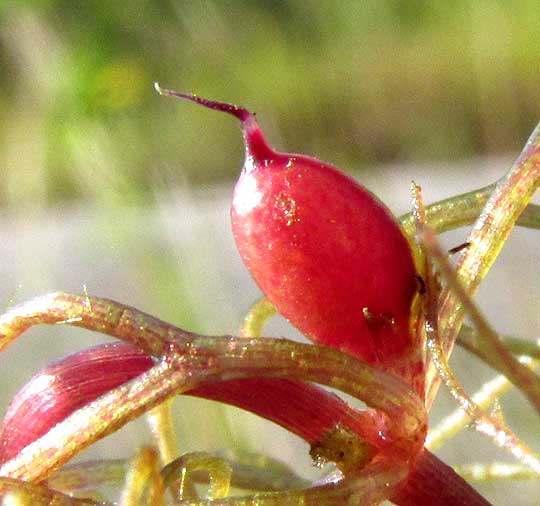Excerpts from Jim Conrad's
Naturalist Newsletter

from the November 23, 2014 Newsletter issued from Río Lagartos, on the Yucatan Peninsula's northern coast (~N21.60°, ~W88.16°), Yucatán state, MÉXICO
TROPICAL HORNWORT
In a partially shaded, small, shallow pond in a generally marshy area along the road between Río Lagartos and San Felipi just to our west, knee deep water was about as thickly populated with a feathery, submerged aquatic plant as it could be. Above, you can see some strands of the plant draped on my hand. Up close, the leaves showed themselves as twice divided into threadlike filaments, as shown below:

Several widely distributed aquatic plants look more or less like this so at first I felt sure I'd never be able to identify it with certainty. However, then I noticed that some of the submerged stems bore tiny, bright-red fruits in the axils of their leaves. You can see one emerging from its five-lobed calyx below:

Now I could recognize the plant as a kind of usually-overlooked hornwort, genus Ceratophyllum, which back in my student days I'd been thrilled to find populating shallow waters in swamps back in Kentucky -- those swamps now converted to soybean fields. In the world of flowering plants, the angiosperms, the Hornwort Family is distinguished by its species lacking roots, cuticle, stomata and woody or fibrous tissue. The flowers are also reduced and specialized for pollination under water.
Even today it's hard to figure out where hornworts belong on the Phylogenetic Tree of Life. Recent research suggests that the family is so ancient that it branched off at about the same time the ancestors to all monocots and dicots arose. Thus hornworts are best thought of as neither monocots nor dicots, but rather their own thing, and that in itself is something to think about when you're standing there with wet, fruiting hornworts dangling from your fingers.
Anyway, having fruits to work with -- which are somewhat unusual among hornworts in that they lack spines and are so brightly red -- our Río Lagartos plants worked out to the Tropical Hornwort or Soft Hornwort, CERATOPHYLLUM SUBMERSUM. That species occurs in habitats exactly like the little roadside pond on the way to San Felipe, basically worldwide.
But, there's such debate and confusion among experts that any hornwort identification is bound to be contested by someone. Our Tropical Hornwort is one of two well-defined cosmopolitan species, the other being Ceratophyllum demersum, which is more likely to be found in temperate zones. Both species are listed for the Ría Lagartos Biosphere Reserve. More than 30 hornwort species have been described and defined mainly on the basis of fruit-spine number and position, but, according to a hornwort expert, VH Heywood, most are probably no more than variants of those two common species.
Still, our plants fairly well match features regarded to be those of the Tropical Hornwort, and that's how I'll file it here until someone tells me otherwise. What's important is for the world to know that we have what's shown in our pictures in the Río Lagartos area of northern Yucatán.